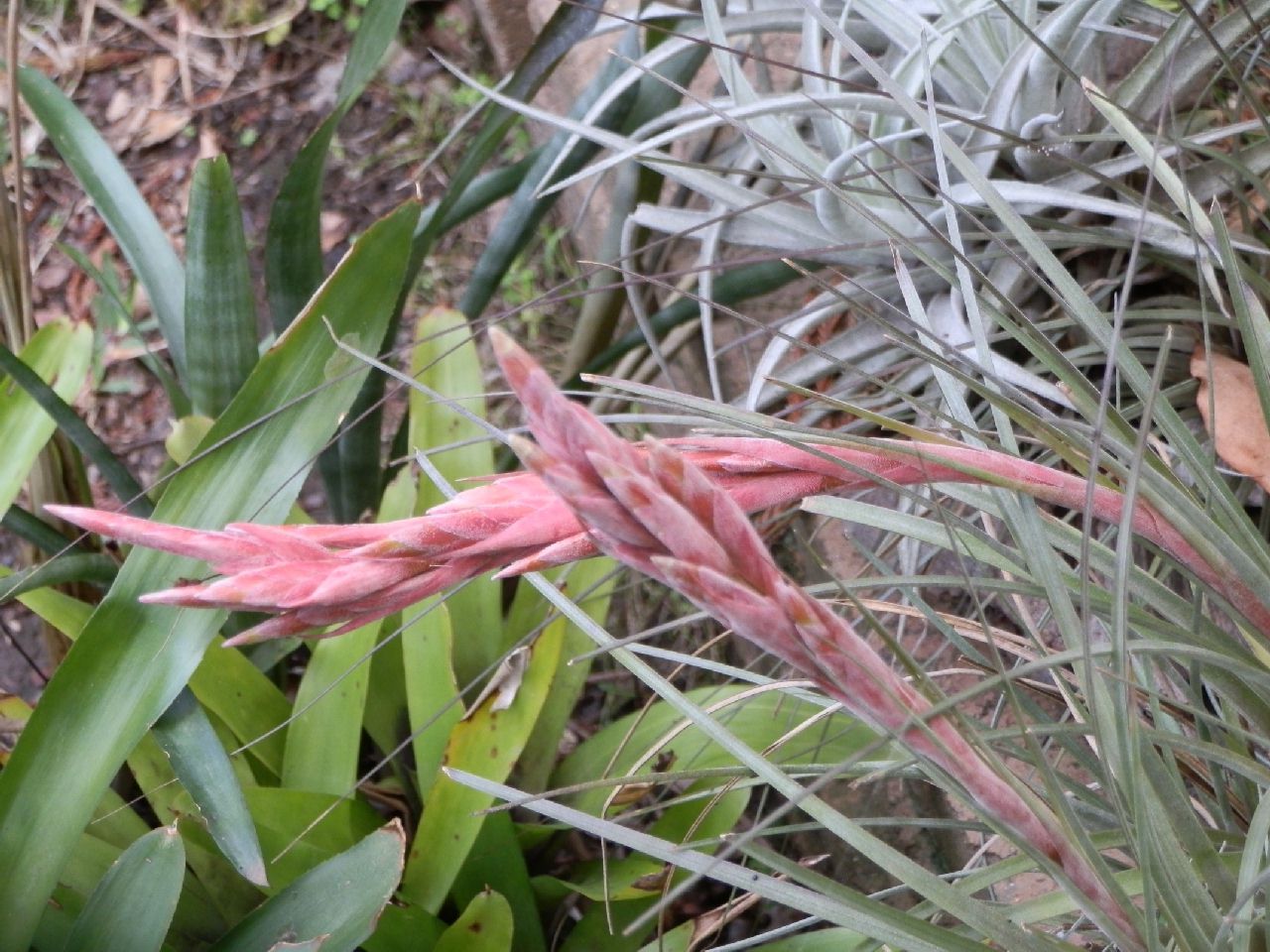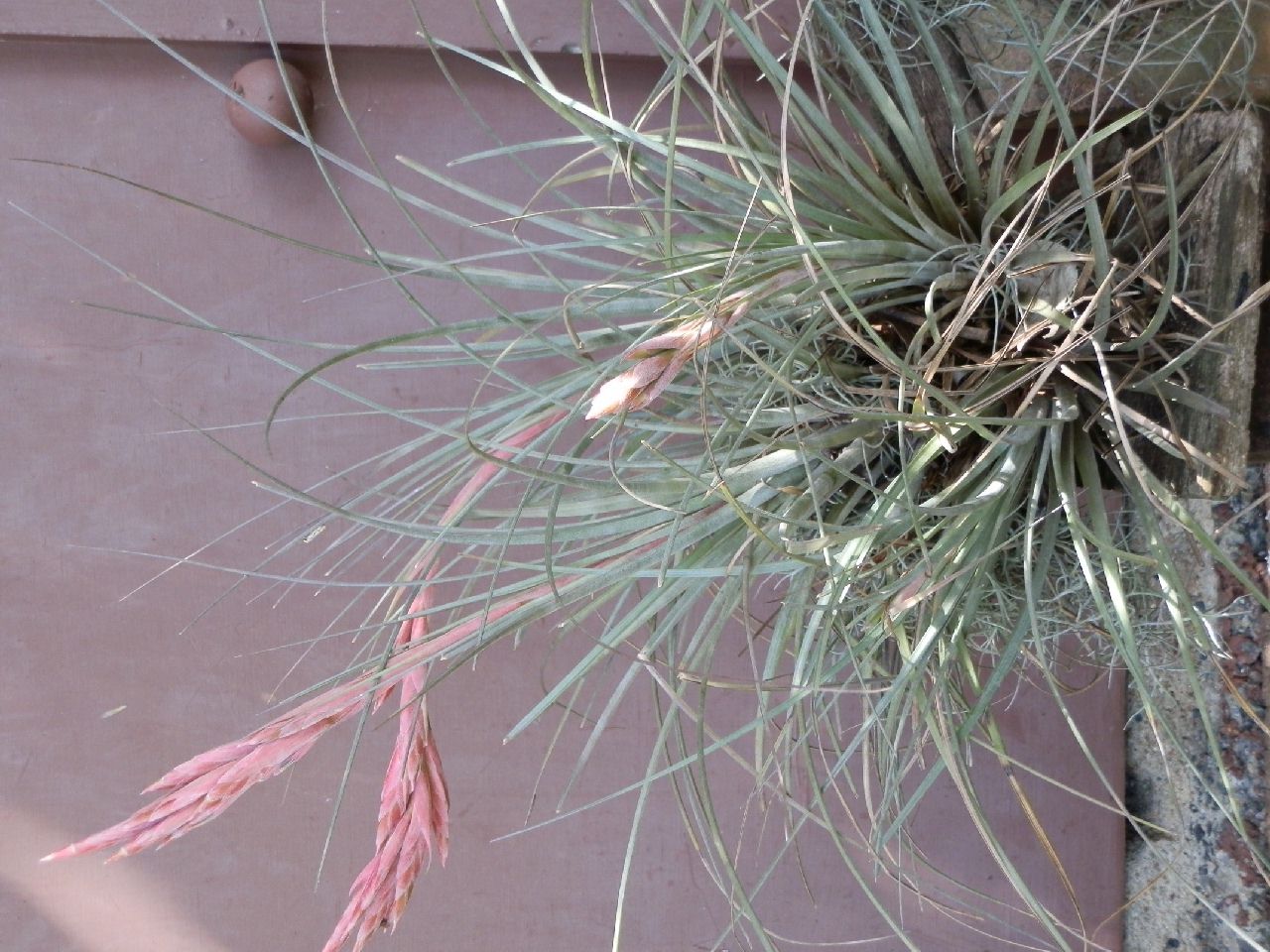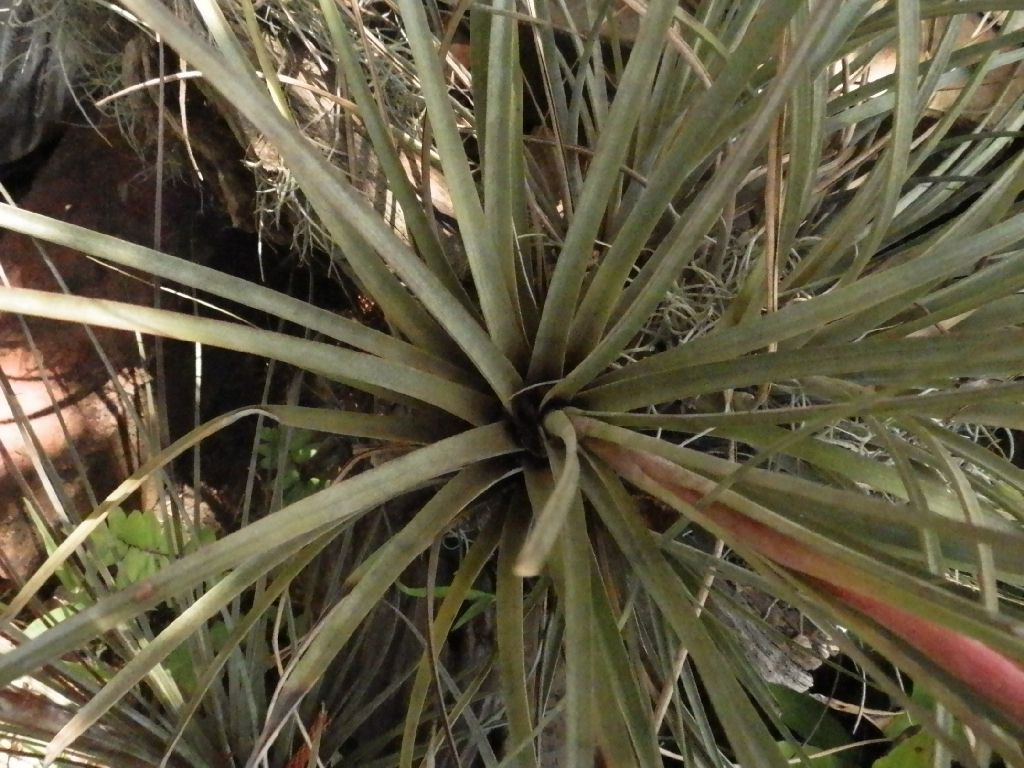
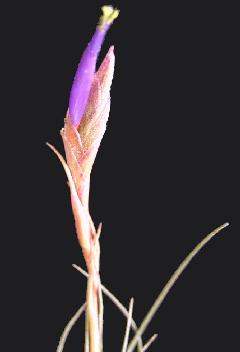
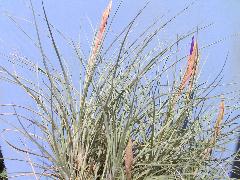
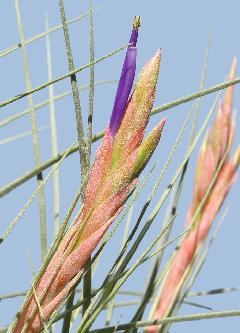
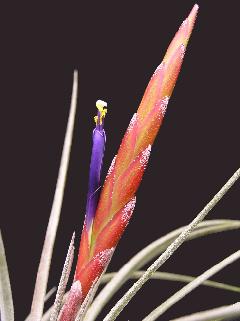

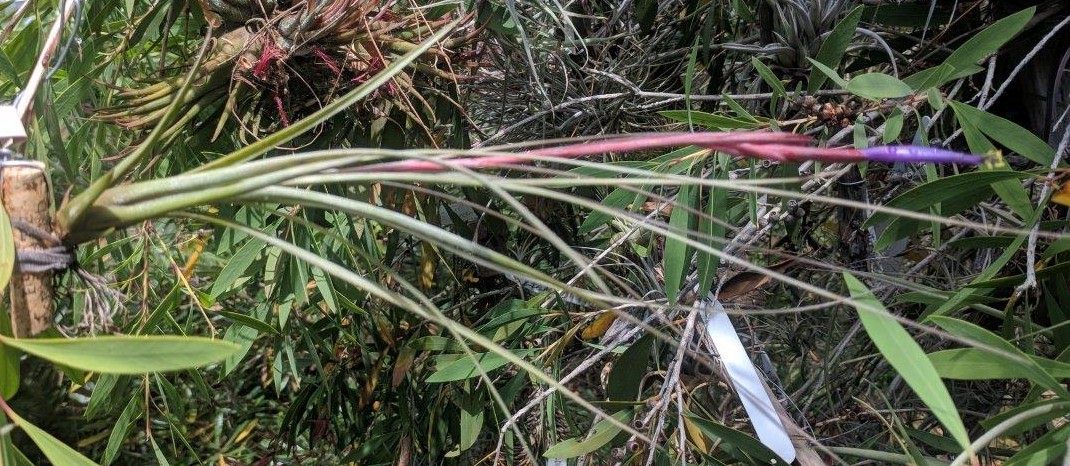
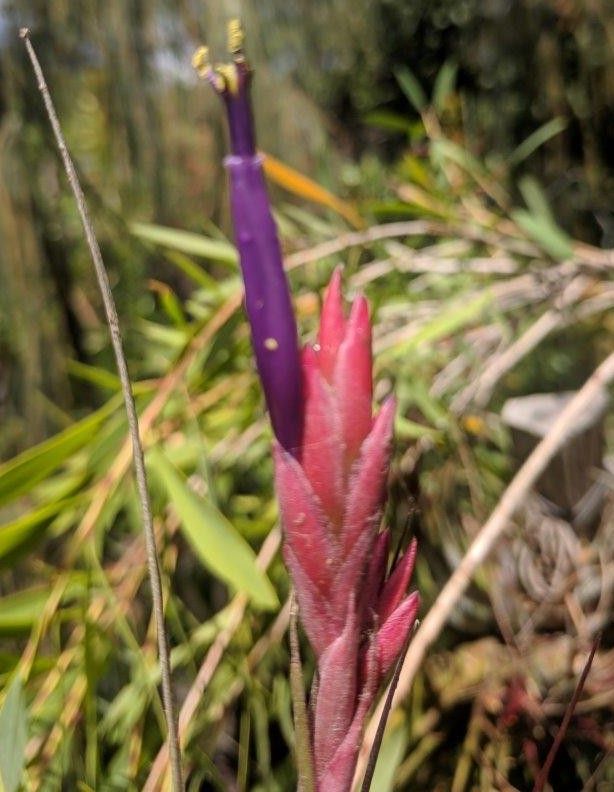
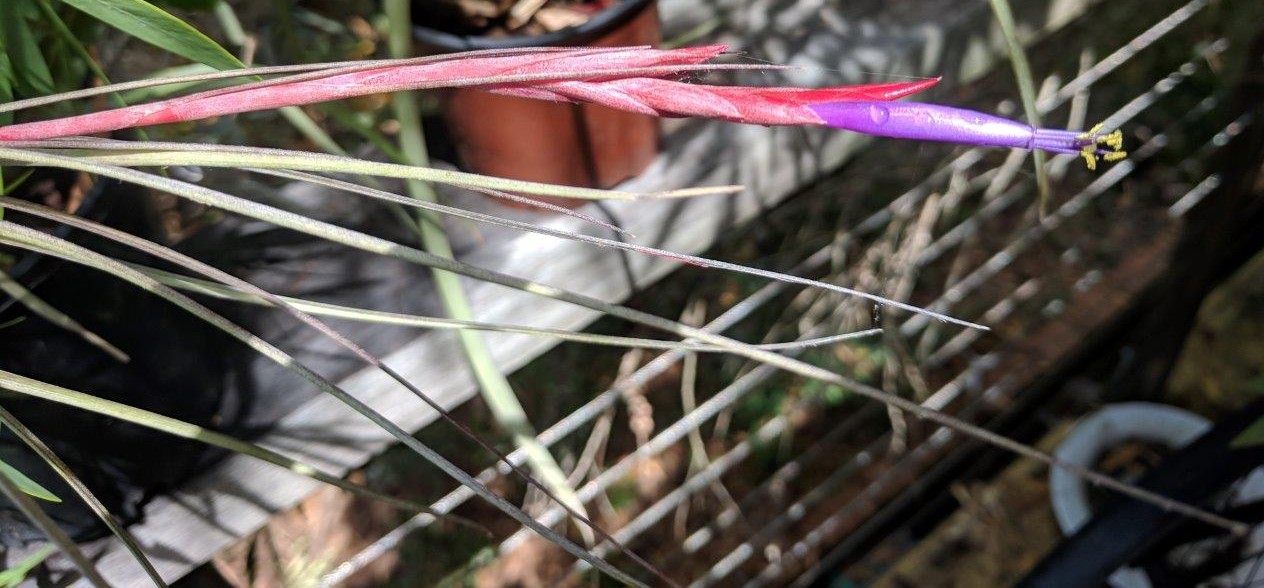
In 1979 Lyman Smith was treating T. simulata as a synonym of T. bartramii. In 1982, in her PhD dissertation, Sue Gardner split T. simulata from T. bartramii. Normally these dissertations are not accepted as valid publications by the botanic fraternity. In 1986 in Selbyana 9: 130 - 146 T. simulata is NOT mentioned by Gardner in her Tillandsia Classification System! In 1994 in Selbyana 15:36 in De Rebus I, Luther and Sieff showed them as separate species and I assume this legitimises Gardner’s Dissertation in 1982.
What are the differences? From photocopies of herbaria material sent to me by Harry Luther the main difference seems to be in a triangular leaf sheath for T. bartramii and a narrow-oval shaped leaf sheath for T. simulata.
At the Orlando Conference in 1996 Harry Luther spoke on the native Tillandsias of Florida. Part of a map printed in the “Proceedings” is shown here indicating where both species can be found.
On 4 July 1998 in Brom-l, Kenneth Quinn reported on some fieldwork he had done. Remember he is not a Botanist and lost his original work on the subject and is reporting from memory.
I quote ” The purpose of the trip was to find out if T. bartramii and T. simulata were separate species, at least to the extent that they could be separated on vegetative characteristics. In Flora Neotropica T. simulata is treated as a synonym of T. bartramii, but the more I read the more I wondered. After examining herbarium specimens at Marie Selby Gardens, and my field work, I am convinced that they are indeed separate. T. bartramii has very narrow leaves and the numerous leaves in the rosette are held almost vertically. T. simulata has fewer, broader leaves and they are recurved; they also are in a flatter rosette. T. bartramii is found mostly north of Kissimmee, T. simulata south.
The area around Kissimmee seems to be the home of a hybrid swarm, with those two species and T. fasciculata interbreeding rather freely. In this area the 1989 freeze killed nearly all epiphytic specimens but those that rooted in the sandy soil fared much better, probably due to residual heat of the ground. T. setacea, abundant several years earlier, was almost gone.”
So looking at Andrew’s plants I believe that they are T. simulata, hoping of course that the seed was not originally collected in the Kissimmee area where we now know a hybrid swarm exists.
If anyone has access to Small’s original description of T. simulata in Man. South east. Fl. 270, 1503. (1933) it would be great to get a copy. Of even greater interest is the names that must be on labels on plants held in captivity in Florida. How many of you have checked?
The principal range of Tillandsia bartramii appears to lie in the southeastern United States, where it is relatively common from southern Georgia to south-central Florida, widely disjunct from the scattered Mexican localities at which it is known in Tamaulipas, San Luis Potosi, Oaxacana, and Guerrero, and one locality in Guatemala. It proves to be rather abundant in the coastal lowlands of Jalisco and southern Nayarit, this representing another marked disjunction in its range as far as that is known at present.
In Jalisco and Nayarit T. bartramii and a very similar species, T. setacea, grow in more or less the same habitats and are easily confused, though if plants of the two are directly compared, some subtle differences usually become apparent. The herbage in T. setacea is a brighter green, and the bracts are commonly green, whereas in T. bartramii the herbage tends to be gray, and the bracts wholly or partially pink or purplish. The leaves of the two, though linear-filiform in both, are recognizably different. Smith (Phytologia 13: 454. 1966) pointed out that in the southeastern United States the leaves (blades) of T. bartramii are "crescent-shaped in section and at least 1 mm in diameter at mid-point, " whereas those of T. setacea are "completely involute, strongly ribbed, and about 0.5 mm in diameter at mid-point."
The situation is much the same in Nueva Galicia. In T. bartramii the leaf-blades tend to be inrolled, at midpoint rather obscurely ribbed on the outer (abaxial) surface, and rounded on the concave inner surface; in T. setacea the blades are narrower (as noted by Smith) and at midpoint are often sharply folded, and as often strongly angled on the outer surface and seemingly triangular or tetragonal in section.
In the Flora Neotropica (Smith & Downs, 1977) the same two species were formally contrasted as follows:
1......Leaf-sheaths 15-20 mm wide; blades of the primary bracts generally exceeded by the axillary spikes. => T. bartramii.
1......Leaf-sheaths ca 8 mm wide: blades of the primary bracts generally exceeding the axillary spikes. => T. setacea.
These characters do not seem to provide useful distinctions in Nueva Galicia. It is true that the sheaths (like most other parts of the plant) are slightly larger (on the average) in T. bartramii, but dimensions often overlap. The bract character is even more difficult to evaluate. In our specimens, at least, the primary bracts in T. bartramii may have long caudate tips that clearly are longer than (not shorter than) the axillary spikes. Magana said of these bracts, "equalling or exceeding the spikes"; of T. setacea she said, and in this I concur, "primary bracts generally shorter than the spikes." Elsewhere she noted that the lowest primary bracts may be longer than the spikes, as described in Flora Neotropica. Apparently bract length is not consistently the same, in either species.
Tillandsia myriophylla Small
Plant gray and reddish-pink scurfy, 1 – 3dm tall, the stems few or many together
Leaves basal ones erect or ascending with the very slender tips straight or curved.
Blades with a ‘V’-shaped upper face.
Scape bracts with erect or appressed, elongate almost filiform but stiff quill-like tips, the upper ones often reddish-pink
Floral bracts reddish-pink tinged.
Petals violet, about 4cm long.
Capsule rather slender about 2.5cm long.
Habitat Hammocks, often in the hilly parts, Peninsular of Florida
Type. Brooksville, Hernando County, Florida, Small & Alexander s n (NY).
From Small in Man. SE. Florida Bromeliaceae 1933 Courtesy of Harry Luther 2001 with current situation regarding names!
3. TILLANDSIA L. Stiff, epiphytic, solitary or gregarious plants with leafy flower-stems. Leaves several or many, mainly in a basal rosette, flat or dilated and sometimes saccate at the base, those on the flowering stem more or less reduced. Flowers in simple or branched spikes with imbricate bracts. Style filiform, much longer than the ovary: About 350 species, natives of warm and tropical America.- AIR-PLANTS. WILD-PINES.
Main rachis of the inflorescence covered with the closely imbricate more or less distichous bracts. => I. FASCICULATAE.
Main rachis of the inflorescence exposed, the bracts, at least neither imbricate nor distichous.
Bracts, flowers, and capsules appressed to the rachis: flowers sessile: corolla cream-color or ivory-white. => II. UTRICULATAE
Bracts. flowers, and capsules lax or spreading: flowers pedicelled : corolla lavender to rose-purple. => III. ALOIFOLIAE
I. FASCICULATAE
Leaves with short slightly-dilated bases which are narrowed into elongate-subulate straight erect tips. => 1. T. tenuifolia.
Leaves with long much dilated bases which are narrowed into short or elongate carved or twisted tips.
Leaf-bases flat or nearly so, not forming a bulb-like swelling at the base of the flower-stem.
Basal leaves erect or ascending except the more or less spreading or curled tips
Inflorescence not contracted, the lateral branches erect or ascending.
Leaf-blades with a concave upper face: stem¬-leaves with ascending or spreading slender tips => 2. T. simulata.
Leaf-blades with a V-shaped upper face: stem- leaves with erect or appressed filiform tips. => 3. T. myriophylla.
Inflorescence contracted into an ellipsoid head which is subtended by an involucre. => 4. T. juncea.
Leaves and bracts coriaceous : bracts loosely imbricate and separated in fruit. => 5. T. valenzuelana.
Leaves and bracts chartaceous : bracts permanently approximate and closely imbricate.
Leaves stiff, straight or nearly so, in a bristly spreading basal cluster, the short base abruptly narrowed into an elongate dagger-like tip: petals spatulate => 6. T. hystricina.
Leaves not stiff, strongly curved, in a large recurving basal rosette, the long base gradually narrowed into the rather wide tip: petals linear. => 7. T. fasciculata.
Leaf-bases inflated. forming a bulb-like swelling at the base of the flower stem.
Basal leaves with long pliable whip-like tips: corolla violet: flowering-stem elongate, much easerted from the cluster of basal leaves.
Basal leaves with the tips elongate, tentacle-like, abruptly reflexed and spirally twisted. stem leaves with abruptly recurved tips: spikes lanceolate, the bracts narrow. => 8. T. balbisiana.
Basal leaves with the tips not tentacle-like, ascending: stem-leaves with erect tips: spikes linear¬ elliptic, the bracts broad. => 9. T. polystachya.
Basal leaves with short rigid tips: corolla lavender: flower-stem very short, protruding from the cluster of basal leaves only in fruit, if at all. => 10. T. circinata.
II UTRICULATAE
Tall plant with numerous long, flat or nearly flat, widely recurving, basal leaves: flower-stem many-flowered. => 11. T. utriculata.
III. ALOIFOLIAE
Low plant with the few short basal leaves, erect or nearly so and spirally twisted : flower-stem few-flowered. => 12. T. aloifolia.
1. T. tenuifolia L. (Now treated as T. setacea) Plant green, dark-red, or purple-red, 1-3 dm. tall, the stems and leaves often in dense clusters: leaves quill-like, often exceeding the stem: spikes few-flowered: petals violet, about 3 cm. long: capsule 2.5-3 cm. long. {T. Bartramii Ell. T. caespitosa LeConte} --Hammocks and swamps, Coastal Plain, Fla. and Ga.---(W. L, C. .A., S. A.)
2. T. simulata, Small. Plant pale-green or gray-green, scurfy and red, 2-4 dm. tall, the stems solitary or fen together: basal leaves erect or ascending, with the slender tips often becoming filiform and curled: leaves of the flower-stem with long slender greatly elongate quill-like tips, the upper ones often red: spikes with the bracts red tinged: petals violet, about 4.5 cm. long: capsule stout, about 3 cm. long. {T. angustifolia (Chapm. Fl.) ?} - Hammocks, often along streams and swamps, pen. Fla.
3. T. myriophylla Small. (Now treated as T. bartramii) Plant gray and reddish-pink scurfy, 1-3 dm. tall, the stems few or many together: basal leaves erect or ascending with the very slender tips straight or curved: leaves of the flower-stem with elongate almost filiform but stiff quill-like tips, the upper ones often reddish-pink: spikes with the bracts reddish-pink tinged: petals violet, about 4 cm. long: capsule rather slender about 2.5 cm. long.---Hammocks, often in the hilly parts, pen. Fla.
4. T. juncea (R. & P.) Poir. (Now treated as T. xfloridana) Plant gray-green, 1.5-3.5 cm. tall, the stems usually several together: basal leaves mostly ascending, some of the outer ones recurved-spreading; leaves of the flower-stem with elongate-subulate, quill-like , strictly erect or appressed tips, the upper ones often red-tinged: spikes congested, the lateral branches short, thus the whole inflorescence contracted into a terminal more or less elongate cluster: bracts red or red-tinged: petals violet, about 3 cm, long: capsule stoutish, 2.5-3 cm. long.-Hammocks, pen. Fla.:(W. I, C.A.,S.A.)
Date: Sat, 4 Jul 1998 From "Kenneth Quinn"
Bromeliads and disasters.
I would be extremely interested in reading about your study.
OK then..... this will be a long post, delete now if not interested. Let me start off with a few warnings. I no longer have the manuscript, due to a crashed hard disk and a useless backup diskette. Also, I have little formal training in botany, so these were the observations of an educated layman, not a professsional. Thirdly, a badly sprained ankle meant I had to cut off fieldwork before I planned to.
The purpose of the trip was to find out if T. bartramii and T. simulata were separate species, at least to the extent that they could be separated on vegetative characteristics. In Flora Neotropica, simulata is treated as a synonym of bartramii, but the more I read the more I wondered. After examining herarium specimens at Marie Selby Gardens, and my fieldwork, I am convinced that they are indeed separate. T. bartramii has very narrow leaves and the numerous leaves in the rosette are held almost vertically. T. simulata has fewer, broader leaves and they are recurved; they also are in a flatter rosette. bartramii is found mostly north of Kissimmee, simulata south. The area around Kissimmee seems to be the home of a hybrid swarm, with those two species and T. fasciculata interbreeding rather freely. As I mentioned, in this area -the 1989 freeze killed nearly all epiphytic specimens but those that had rooted in the sandy soil fared much better, probably due to residual heat of the ground. T. setacea, abundant several years earlier, was almost completely gone.
In Myakka River State Park, just east of Sarasota, there was much less damage; large, flowering specimens of T. fasciculata and T. utriculata were everywhere in the live oak hammocks, and T. setacea was very abundant.
Neither bartramii or simulata were seen by me. I did notice the tillandsias were almost always attached to the lower half of the horizontal tree limbs; the phenomenon has also been noted on tropical rainforest trees and was attributed to animal traffic along the branches, but I wonder if the raindrops of those fierce thunderstorms were responsible. They could knock off most seedlings before rooting occurred.
Highlands Hammock State Park is at pretty much the same latitude but is far inland (at least for Florida), being just west of Sebring. My memory of that area is fuzzier but I seem to recollect seeing evidence of much destruction, in particular a huge number of rootballs left on the trunk but some adult Tillandsias were still on the trees.
Nearby, just a bit south, is Lake Placid. On a biological research station just east of there, the tillandsia population semed in good health.
To my surprise, I found T. paucifolia (the old T. circinnata) fairly abundant and definitely predating the freeze. I believe this is the northernmost record of that species in Florida.
Farther south, in Punta Gorda, Naples, and the Corkscrew Sanctuary, I saw no evident damage. The Fahkahatchee Strand also seemed undamaged; T. valenzuela (I know it has a new name) was abundant but many specimens, at least a third, were moribund for no apparent reason. I saw no signs of insect damage. On the other hand, I did see a T. pruinosa in great shape.
I visited areas north of Orlando, but cannot remember much about them. Multiple sclerosis has affected my memory, and has left holes in it.
Further from Ken Quinn
29 Jun 2008
Sender: Discussion list about Bromeliaceae and relavant topics
From: Kenneth Quinn
Subject: Tillandsia bartramii in South Carolina
I was looking at the USDA PLANTS database, and it shows T. bartramii in South Carolina. Somehow I missed that - is there a published record of this?
Kenneth Quinn
HEL says this an error!
Tillandsia bartramii Elliott. Sketch Bot. Soc. Carol. & Georgia. 1: 379. 1817.
2. Bartramii, E.
T. foliis subulatis, canaliculatis, pruinosis, erectis, basi dilatatis cartilagineisque; scapo simplici foliis breviore, summitate bifloro. E.
Leaves subulate, channelled, hoary, erect, dilated and cartilaginous at base; scape simple, shorter than the leaves, 2 flowered at the summit.
Tillandsia monostachya? Bartram’s Travels, p59
Root fibrous, insinuating itself into the bark and decayed wood of old trees. Leaves about a foot long, subulate, or semiterete, channelled on the inner side, covered with whitish leprous scales. Spike simple, leafy; the upper leaves lanceolate, acuminate, imbricate, tinged at the base with pink, the last bearing in its bosom two flowers.
This is most probably the Tillandsia seen by Bartram near the Alatamaha. It has lately been discovered again by Lewis LeConte, Esq. in Liberty county, Georgia, growing on old trees in the Mortar Swamp, to whom I am indebted for fine specimens, which however had only begun to bud. It appears to me, as it did to Mr. LeConte, to differ from any species discribed in Persoon, the latest authority to which we could refer.
It resembles more the figure in Sloan, No. 122, fig.1, than his figure of the recurvata, No. 121, fig.1. Flowers June
From Smith in Phytologia 13(7): 454-5. 1966
TILLANDSIA BARTRAMII Ell. Bot. S. C. & Ga. 1: 379. 1817.
Tillandsia juncea sensu Leconte, Ann. Lyc. N. Y. 2: 130. 1826; Mez in DC. Mon. 9: 676. 1896, quoad pl. Florid., non Poir.
? Tillandsia pinifolia Leconte, Ann. Lyc. N. Y. 2: 131. 1826.
Tillandsia tenuifolia sensu Mez in DC. Mon. 9: 674. 1896; Small, F1. Se. U. S. 245. 1903, quoad syn. Tillandsia bartramii Ell.
Tillandsia simulata Small, Man. Se. Fl. 270, 1503, 1933. NOTE THAT THIS SPECIES WAS RESURRECTED BY GARDNER in her dissertation in 1982 and confirmed in DeRebus I 1994
Tillandsia myriophylla Small, Man. Se. Fl. 270, 1503. 1933.
UNITED STATES: GEORGIA: On old trees in the Mortar Swamp, Liberty County, Lewis LeConte s. n. (CHARL, holotype, phot. GH; NY, Isotype).
FLORIDA: Manatee River (Manatee County), June 1878, A. P. Garber s. n. (NY, lectotype of Tillandsia simulata Small; US, Isotype). Hammock south of Brooksville, (Hernando County), May 13, 1931, J. K. Small & E. J. Alexander s. n. (NY, type of Tillandsia myriophylla Small)
In the extreme southeastern United States, the group of species of Tillandsia subgenus Tillandsia with very narrow fasciculate leaves is extremely confused and confusing, and I fear that my efforts in the North American Flora in l938 did little to improve the situation. There, following previous authors, I misapplied T. juncea (R. & P.) Poir., a species that has a very densely digitate involucrate inflorescence and that ranges from Mexico and the West Indies to Peru and Bolivia. Up to the present, I have seen no authentic material of Tillandsia juncea from Florida.
It is possible to separate T. setacea Sw. (T. tenuifolia auctt., non L.) from the remainder of this complex on its leaves alone, which have very narrow sheaths, and blades that are thin, completely involute, strongly ribbed, and about 0.5 mm in diameter at mid-point (P1. I, fig. 1: Small & Mosier 5506), while those of the remainder are crescent-shaped in section and at least 1 mm in diameter at mid-point (p1. I, fig. 2: LeConte). T. setacea is limited to the southern half of Florida, while the remainder of the complex is rare there but common in the northern half and adjacent Georgia.
I have tried to find characters to separate the remainder of this complex both in the descriptions of Leconte and in those of Small and also independently, but so far in vain. The oldest name is T. bartramii Ell. and judging from the descriptions, T. pinifolia of LeConte belongs here, while his T. caespitosa appears to be a synonym of T. setacea. Types of two of Small’s species have been located as indicated above, but T. hystricina remalns a mystery with indications of relationship elsewhere because of the leaves with "stiff nearly knife-like tips".
In conclusion I should say that for some years research has been going on with the purpose of distinguishing entities in this complex, but until that is successful there is no choice but to use T. setacea and T. bartramii for the southern and northern species respectively.
